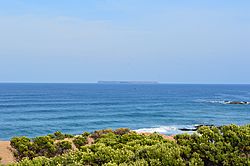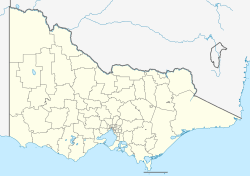Lady Julia Percy Island facts for kids
|
Native name:
Deen Maar
|
|
|---|---|

Lady Julia Percy Island seen from the Yambuk Flora and Fauna Reserve
|
|
| Geography | |
| Location | Bass Strait |
| Coordinates | 38°25′30″S 142°00′00″E / 38.42500°S 142.00000°E |
| Area | 1,330 ha (3,300 acres) |
| Length | 2.4 km (1.49 mi) |
| Width | 1.2 km (0.75 mi) |
| Administration | |
|
Australia
|
|
| State | Victoria |
Lady Julia Percy Island, known as Deen Maar or Dhinmar in the Gunditjmara language lies 6 kilometres (3.7 mi) off the coast, in the Barwon South West region of Victoria, Australia in Bass Strait.
Contents
Description
It is 12 kilometres (7.5 mi) south-south-west of Yambuk, and 22 kilometres (14 mi) south-west of Port Fairy. The island is about 2 kilometres (1.2 mi) in length by 1 kilometre (0.62 mi) in width, with an area of 1.33 square kilometres (0.51 sq mi), comprising a plateau, varying in height from 32–46 metres (105–151 ft) asl, surrounded by cliffs, rock platforms and reefs. It contains an important seal breeding colony. It has a long history of human exploitation, which has drastically affected its vegetation communities, though it is now protected as a State Faunal Reserve. It is listed on Australia's Register of the National Estate. It is best viewed from The Crags or Yambuk Lake, both of which are in the Yambuk area.
History
Deen Maar was well known to the Gunditjmara people; it is believed that the spirits of the dead were conveyed across the sea to the island from a cave called Tarnwirring ("the flowing of the wind") at the top of a rocky sea cliff. The island was also known as Tirngoona, meaning "where the sun go away longa night".
The island was given the name "Lady Julia’s Island" in 1800 by Lt James Grant after either the wife or daughter of Hugh Percy, 2nd Duke of Northumberland. In 1802 Matthew Flinders expanded the name to Lady Julia Percy's Island as he sailed past on his ship the Investigator. Also in 1802, Nicolas Baudin sailed past the island in his ship the Géographe, and recorded the island as Ile aux Alouettes, a name that has not persisted.
During the early 19th century, sealing took place with sealing gangs living on the island often for months at a time. There are two graves on the island – one of a sealer buried in 1822, and one of a man named Hardman buried in 1828 by Captain Wishart of the Fairy. Guano was mined on the island for fertiliser until 1861, being transported to Port Fairy in barges.
In January 1936 a scientific expedition from Melbourne University's McCoy Society visited the island for six weeks and carried out a comprehensive ecological survey.
Environment
Geology
Formed some seven million years ago, the island is much older than other volcanoes in the region, and is also unusual in being built by both submarine and terrestrial eruptions. It provides exposures of internal volcanic structure, including a volcanic vent. Six successive lava flows can be seen in the coastal cliffs. It is Australia’s only off-shore volcano and the only large basalt island off the coast of western Victoria. Lady Julia Percy Island is considered part of the Newer Volcanics Province — this polycyclic volcano erupted in two phases, at 7.80 ± 0.08 Ma and 6.22 ± 0.06 Ma
Flora
With regard to the flora, Frederic Wood Jones said in 1936 of the island, following his leadership of the 1936 McCoy Society expedition:
"A century ago it was covered with a dense, almost impenetrable, growth of the mixed bushy scrub that characterizes certain parts of the coast of the adjacent mainland. Some sixty years ago this dense scrub was still standing over the major portion of the island; but to-day the whole of the plateau is devoid of any growth more majestic than bracken fern and thistles. The whole plateau is, at present, a windswept area, clothed only by vegetation knee-high at the best, and at the worst, by loose volcanic soil or bare rock. This denudation of forest cover is due to human interference, for pigs were at one time turned down on the island, rabbits were liberated and are still living in their thousands, and sealers, fishermen and guano workers have cut down and burned the stunted and wind-blown trees that formerly covered the island."
The landscape of the island's plateau is now bleak and windswept. It lacks trees and is still largely covered with grasses and bracken on thin black soil. The dominant vegetation communities are grassland and closed fernland. The vulnerable Shore Spleenwort (Asplenium obtusatum) still survives there.
Fauna
The island is one of four Australian fur seal breeding colonies in Victoria and, with an estimated 27,000 seals, is the largest such colony in Australia. It is occasionally visited by Australian sea lions and southern elephant seals. Pigs and rabbits were previously introduced but have since disappeared or been eradicated.
The island is home to breeding little penguins (2000 pairs), common diving-petrels (1000 pairs), fairy prions (1000 pairs), and short-tailed shearwaters (15,000 pairs). White's skink is the only reptile present. The surrounding waters are visited by great white sharks.
Access
Access to Lady Julia Percy Island itself is restricted, and landing is by permit only. However, boat cruises from Port Fairy to the waters around the island are popular; they allow people to see the seal colony and watch whales and seabirds on the way.


